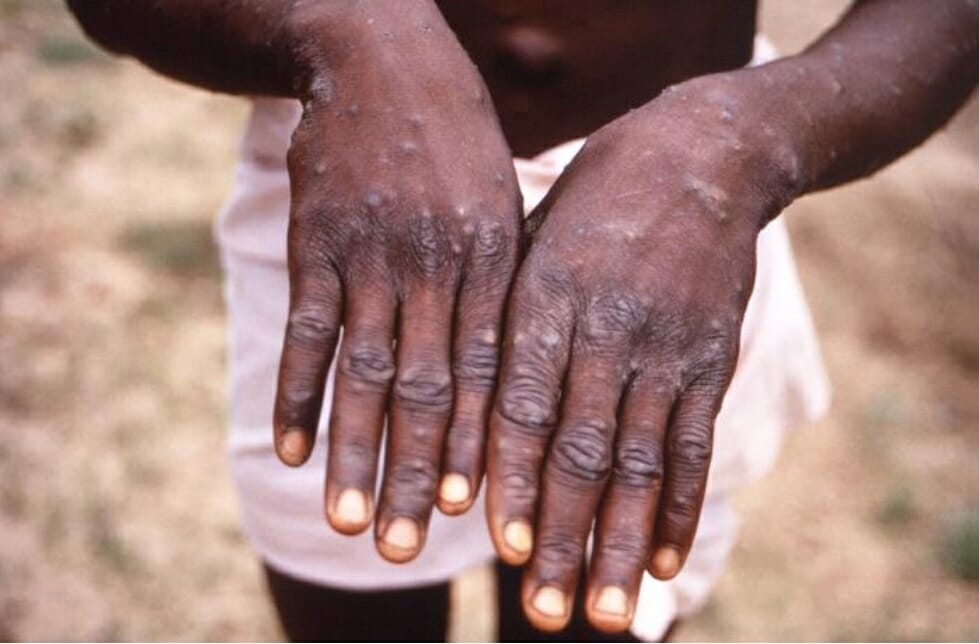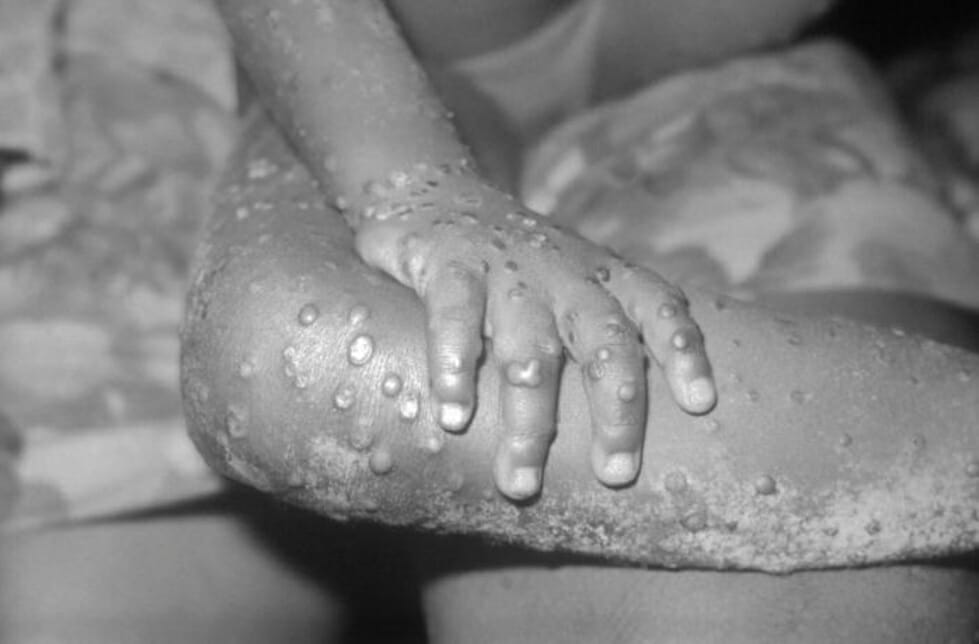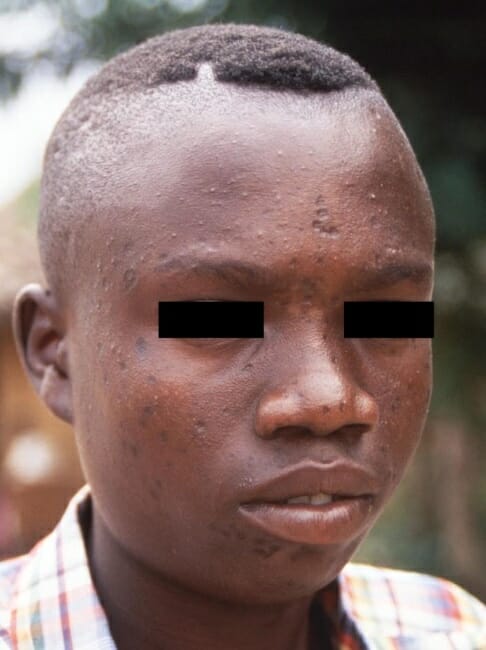Mpox (formerly known as monkeypox Monkeypox A viral disease infecting primates and rodents. Its clinical presentation in humans is similar to smallpox including fever; headache; cough; and a painful rash. It is caused by monkeypox virus and is usually transmitted to humans through bites or via contact with an animal's blood. Interhuman transmission is relatively low (significantly less than smallpox). Orthopoxvirus) is a viral zoonotic disease caused by the mpox virus Virus Viruses are infectious, obligate intracellular parasites composed of a nucleic acid core surrounded by a protein capsid. Viruses can be either naked (non-enveloped) or enveloped. The classification of viruses is complex and based on many factors, including type and structure of the nucleoid and capsid, the presence of an envelope, the replication cycle, and the host range. Virology of the Poxviridae Poxviridae A family of double-stranded DNA viruses infecting mammals (including humans), birds and insects. There are two subfamilies: chordopoxvirinae, poxviruses of vertebrates, and entomopoxvirinae, poxviruses of insects. Orthopoxvirus family. Transmission can be animal to human (by animal bite or by direct contact with bodily fluids) or human to human (by close contact with skin Skin The skin, also referred to as the integumentary system, is the largest organ of the body. The skin is primarily composed of the epidermis (outer layer) and dermis (deep layer). The epidermis is primarily composed of keratinocytes that undergo rapid turnover, while the dermis contains dense layers of connective tissue. Skin: Structure and Functions lesions, respiratory secretions, or contaminated items). The clinical presentation is similar to that of the smallpox Smallpox An acute, highly contagious, often fatal infectious disease caused by an orthopoxvirus characterized by a biphasic febrile course and distinctive progressive skin eruptions. Vaccination has succeeded in eradicating smallpox worldwide. Orthopoxvirus virus Virus Viruses are infectious, obligate intracellular parasites composed of a nucleic acid core surrounded by a protein capsid. Viruses can be either naked (non-enveloped) or enveloped. The classification of viruses is complex and based on many factors, including type and structure of the nucleoid and capsid, the presence of an envelope, the replication cycle, and the host range. Virology, which includes prodromal symptoms such as fever Fever Fever is defined as a measured body temperature of at least 38°C (100.4°F). Fever is caused by circulating endogenous and/or exogenous pyrogens that increase levels of prostaglandin E2 in the hypothalamus. Fever is commonly associated with chills, rigors, sweating, and flushing of the skin. Fever, headache Headache The symptom of pain in the cranial region. It may be an isolated benign occurrence or manifestation of a wide variety of headache disorders. Brain Abscess, myalgia Myalgia Painful sensation in the muscles. Ion Channel Myopathy, and lymphadenopathy Lymphadenopathy Lymphadenopathy is lymph node enlargement (> 1 cm) and is benign and self-limited in most patients. Etiologies include malignancy, infection, and autoimmune disorders, as well as iatrogenic causes such as the use of certain medications. Generalized lymphadenopathy often indicates underlying systemic disease. Lymphadenopathy. The rash Rash Rocky Mountain Spotted Fever begins about 5 days after symptom onset; it typically presents as macules and later develops into papules, vesicles Vesicles Female Genitourinary Examination, and pustules. These lesions become dry (crusts) and fall off. Polymerase chain reaction Polymerase chain reaction Polymerase chain reaction (PCR) is a technique that amplifies DNA fragments exponentially for analysis. The process is highly specific, allowing for the targeting of specific genomic sequences, even with minuscule sample amounts. The PCR cycles multiple times through 3 phases: denaturation of the template DNA, annealing of a specific primer to the individual DNA strands, and synthesis/elongation of new DNA molecules. Polymerase Chain Reaction (PCR) testing of clinical specimens ( skin Skin The skin, also referred to as the integumentary system, is the largest organ of the body. The skin is primarily composed of the epidermis (outer layer) and dermis (deep layer). The epidermis is primarily composed of keratinocytes that undergo rapid turnover, while the dermis contains dense layers of connective tissue. Skin: Structure and Functions lesions) is the preferred diagnostic method. The disease is usually self-limited, lasting for around 2–4 weeks. Generally, supportive management is given. Antiviral Antiviral Antivirals for Hepatitis B agents, such as tecovirimat Tecovirimat Orthopoxvirus, can be given to patients Patients Individuals participating in the health care system for the purpose of receiving therapeutic, diagnostic, or preventive procedures. Clinician–Patient Relationship with or at risk for severe disease.
Last updated: Dec 15, 2025
Mpox (formerly known as monkeypox Monkeypox A viral disease infecting primates and rodents. Its clinical presentation in humans is similar to smallpox including fever; headache; cough; and a painful rash. It is caused by monkeypox virus and is usually transmitted to humans through bites or via contact with an animal’s blood. Interhuman transmission is relatively low (significantly less than smallpox). Orthopoxvirus) is a viral zoonotic disease caused by the mpox virus Virus Viruses are infectious, obligate intracellular parasites composed of a nucleic acid core surrounded by a protein capsid. Viruses can be either naked (non-enveloped) or enveloped. The classification of viruses is complex and based on many factors, including type and structure of the nucleoid and capsid, the presence of an envelope, the replication cycle, and the host range. Virology. Mpox has a clinical profile similar to that of smallpox Smallpox An acute, highly contagious, often fatal infectious disease caused by an orthopoxvirus characterized by a biphasic febrile course and distinctive progressive skin eruptions. Vaccination has succeeded in eradicating smallpox worldwide. Orthopoxvirus, but is less often fatal.

Transmission electron microscopic image depicting a mpox virion:
This negative stain image shows a single, brick-shaped particle covered with whorled filaments.
Symptoms occurring during this period may include (note that some may not have systemic symptoms):
The course of illness is followed by the development of a rash Rash Rocky Mountain Spotted Fever with the following characteristics:

Lesions on the dorsal surfaces of the hands of an individual with mpox
Image: “12763” by CDC/Brian W.J. Mahy, BSc, MA, PhD, ScD, DSc. License: CC0 1.0
Numerous maculopapular mpox lesions on a young person
Image: “2329” by CDC. License: CC0 1.0Other findings in the 2022 outbreak include:

The face of a young man who recovered from a case of mpox and bore permanent pox mark scars
Image: “12777” by CDC/Brian W.J. Mahy, BSc, MA, PhD, ScD, DSc. License: CC0 1.0Clinicians should suspect mpox in cases with clinical and epidemiologic factors:
When mpox is considered, implement transmission precautions:
| Conclusion | Test/assessment results |
|---|---|
| Suspected |
|
| Probable |
Other
Orthopoxvirus
Orthopoxvirus
Orthopoxvirus is a genus of large, brick-shaped, double-stranded DNA viruses. Several clinically relevant species exist, including variola virus (the cause of smallpox), monkeypox virus, vaccinia virus, and cowpox virus. Transmission varies depending on the species but can be through contact with infected bodily secretions, skin lesions, or fomites.
Orthopoxvirus exposure is not suspected, AND
|
| Confirmed |
|
Epidemiologic classification (within 21 days after onset):
Management may vary depending on practice location. The following is based on WHO and US-based guidelines.
Principles of treatment:
Consider antiviral Antiviral Antivirals for Hepatitis B treatment for:[9]
Treatments available:
Hospitalizations in the 2022 outbreak were noted to be due to:
Prevention:[10]
Isolation:[10,20]
After recovery:[19]
Anyone in contact or who provided care for patients Patients Individuals participating in the health care system for the purpose of receiving therapeutic, diagnostic, or preventive procedures. Clinician–Patient Relationship with mpox should monitor themselves for symptoms:
Vaccines developed against smallpox Smallpox An acute, highly contagious, often fatal infectious disease caused by an orthopoxvirus characterized by a biphasic febrile course and distinctive progressive skin eruptions. Vaccination has succeeded in eradicating smallpox worldwide. Orthopoxvirus can also be used against mpox.
Diagnosis Codes:
This code is used to diagnose mpox (formerly
monkeypox
Monkeypox
A viral disease infecting primates and rodents. Its clinical presentation in humans is similar to smallpox including fever; headache; cough; and a painful rash. It is caused by monkeypox virus and is usually transmitted to humans through bites or via contact with an animal’s blood. Interhuman transmission is relatively low (significantly less than smallpox).
Orthopoxvirus), a viral disease caused by the
monkeypox
Monkeypox
A viral disease infecting primates and rodents. Its clinical presentation in humans is similar to smallpox including fever; headache; cough; and a painful rash. It is caused by monkeypox virus and is usually transmitted to humans through bites or via contact with an animal’s blood. Interhuman transmission is relatively low (significantly less than smallpox).
Orthopoxvirus
virus
Virus
Viruses are infectious, obligate intracellular parasites composed of a nucleic acid core surrounded by a protein capsid. Viruses can be either naked (non-enveloped) or enveloped. The classification of viruses is complex and based on many factors, including type and structure of the nucleoid and capsid, the presence of an envelope, the replication cycle, and the host range.
Virology, characterized by
fever
Fever
Fever is defined as a measured body temperature of at least 38°C (100.4°F). Fever is caused by circulating endogenous and/or exogenous pyrogens that increase levels of prostaglandin E2 in the hypothalamus. Fever is commonly associated with chills, rigors, sweating, and flushing of the skin.
Fever and a distinctive
rash
Rash
Rocky Mountain Spotted Fever.
| Coding System | Code | Description |
|---|---|---|
| ICD-10-CM | B04 | Monkeypox Monkeypox A viral disease infecting primates and rodents. Its clinical presentation in humans is similar to smallpox including fever; headache; cough; and a painful rash. It is caused by monkeypox virus and is usually transmitted to humans through bites or via contact with an animal’s blood. Interhuman transmission is relatively low (significantly less than smallpox). Orthopoxvirus |
| SNOMED CT | 30240005 | Mpox (disorder) |
Evaluation & Workup:
This code is for the
PCR
PCR
Polymerase chain reaction (PCR) is a technique that amplifies DNA fragments exponentially for analysis. The process is highly specific, allowing for the targeting of specific genomic sequences, even with minuscule sample amounts. The PCR cycles multiple times through 3 phases: denaturation of the template DNA, annealing of a specific primer to the individual DNA strands, and synthesis/elongation of new DNA molecules.
Polymerase Chain Reaction (PCR) test performed on a swab from a
skin
Skin
The skin, also referred to as the integumentary system, is the largest organ of the body. The skin is primarily composed of the epidermis (outer layer) and dermis (deep layer). The epidermis is primarily composed of keratinocytes that undergo rapid turnover, while the dermis contains dense layers of connective tissue.
Skin: Structure and Functions lesion, which is the definitive method for confirming an mpox diagnosis.
| Coding System | Code | Description |
|---|---|---|
| CPT | 87593 | Infectious agent detection by nucleic acid ( DNA DNA A deoxyribonucleotide polymer that is the primary genetic material of all cells. Eukaryotic and prokaryotic organisms normally contain DNA in a double-stranded state, yet several important biological processes transiently involve single-stranded regions. DNA, which consists of a polysugar-phosphate backbone possessing projections of purines (adenine and guanine) and pyrimidines (thymine and cytosine), forms a double helix that is held together by hydrogen bonds between these purines and pyrimidines (adenine to thymine and guanine to cytosine). DNA Types and Structure or RNA RNA A polynucleotide consisting essentially of chains with a repeating backbone of phosphate and ribose units to which nitrogenous bases are attached. RNA is unique among biological macromolecules in that it can encode genetic information, serve as an abundant structural component of cells, and also possesses catalytic activity. RNA Types and Structure); Orthopoxvirus Orthopoxvirus Orthopoxvirus is a genus of large, brick-shaped, double-stranded DNA viruses. Several clinically relevant species exist, including variola virus (the cause of smallpox), monkeypox virus, vaccinia virus, and cowpox virus. Transmission varies depending on the species but can be through contact with infected bodily secretions, skin lesions, or fomites. Orthopoxvirus |
Medications:
This code is for
tecovirimat
Tecovirimat
Orthopoxvirus, an
antiviral
Antiviral
Antivirals for Hepatitis B medication that is used to treat severe cases of mpox, particularly in
immunocompromised
immunocompromised
A human or animal whose immunologic mechanism is deficient because of an immunodeficiency disorder or other disease or as the result of the administration of immunosuppressive drugs or radiation.
Gastroenteritis individuals.
| Coding System | Code | Description |
|---|---|---|
| RxNorm | 2054904 | Tecovirimat Tecovirimat Orthopoxvirus (ingredient) |
References